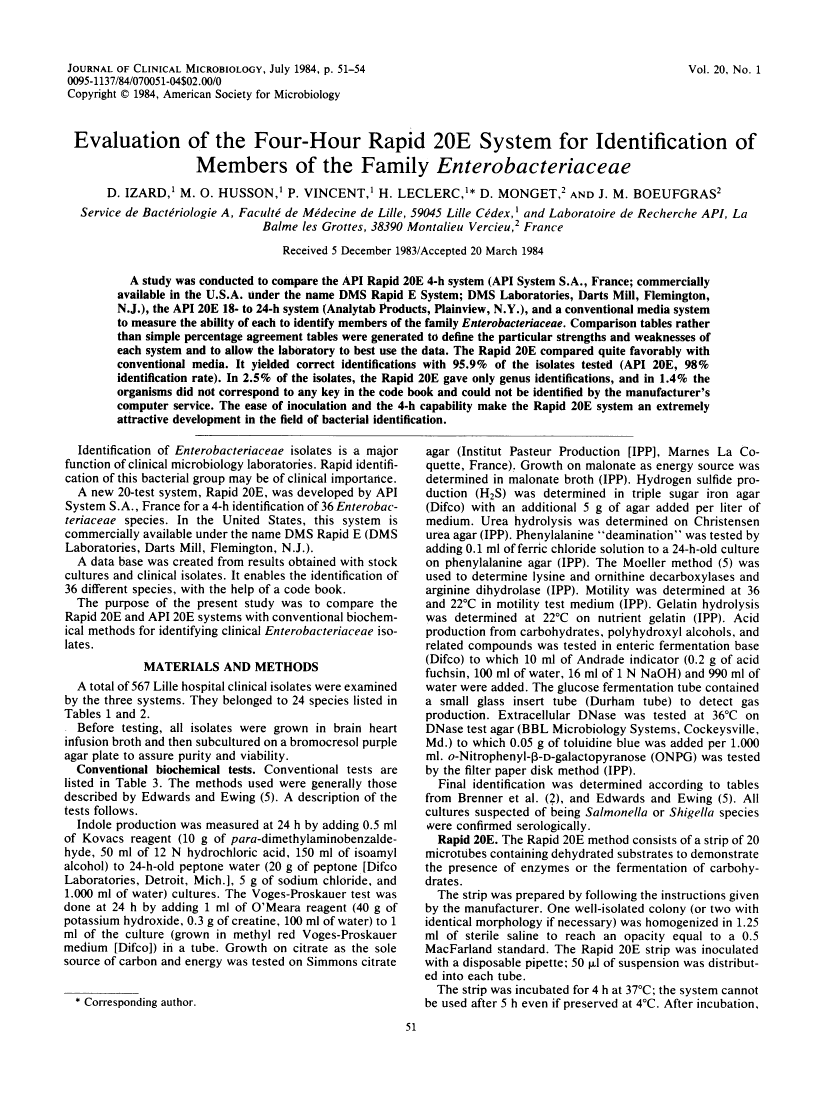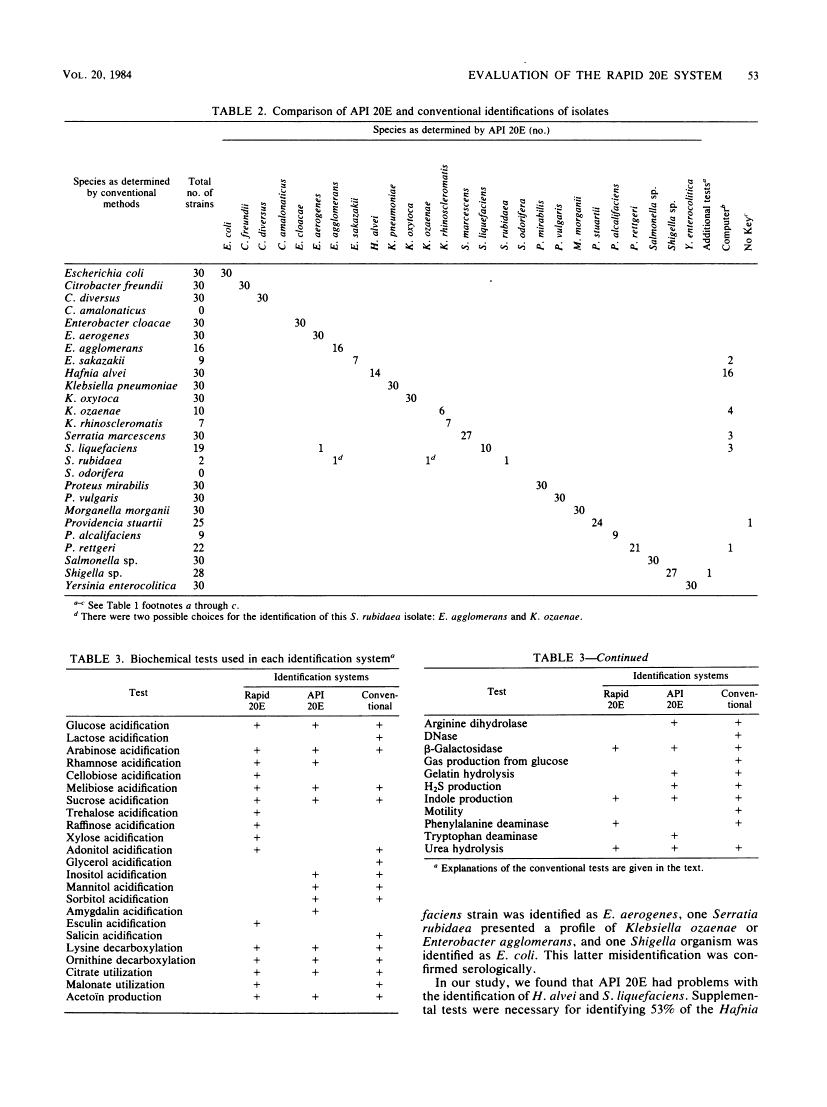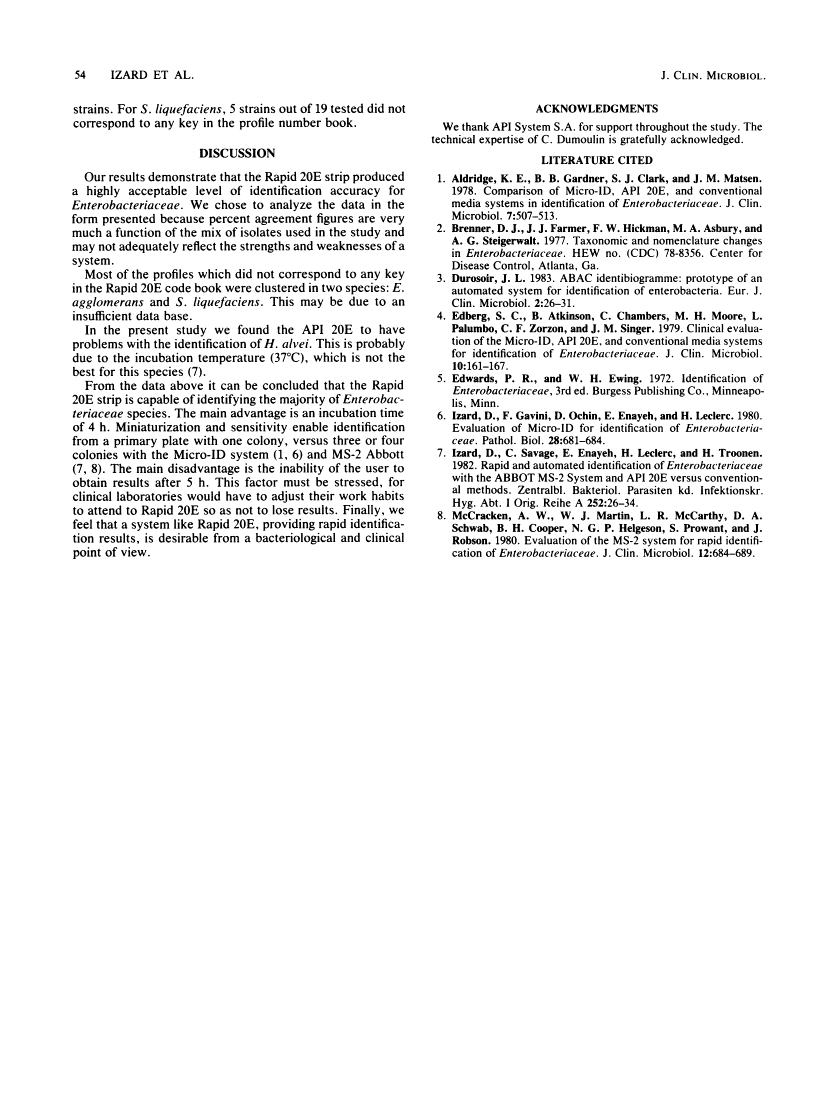Abstract
Free full text

Evaluation of the four-hour rapid 20E system for identification of members of the family Enterobacteriaceae.
Abstract
A study was conducted to compare the API Rapid 20E 4-h system (API System S.A., France; commercially available in the U.S.A. under the name DMS Rapid E System; DMS Laboratories, Darts Mill, Flemington, N.J.), the API 20E 18- to 24-h system (Analytab Products, Plainview, N.Y.), and a conventional media system to measure the ability of each to identify members of the family Enterobacteriaceae. Comparison tables rather than simple percentage agreement tables were generated to define the particular strengths and weaknesses of each system and to allow the laboratory to best use the data. The Rapid 20E compared quite favorably with conventional media. It yielded correct identifications with 95.9% of the isolates tested (API 20E, 98% identification rate). In 2.5% of the isolates, the Rapid 20E gave only genus identifications, and in 1.4% the organisms did not correspond to any key in the code book and could not be identified by the manufacturer's computer service. The ease of inoculation and the 4-h capability make the Rapid 20E system an extremely attractive development in the field of bacterial identification.
Full text
Full text is available as a scanned copy of the original print version. Get a printable copy (PDF file) of the complete article (562K), or click on a page image below to browse page by page. Links to PubMed are also available for Selected References.
Selected References
These references are in PubMed. This may not be the complete list of references from this article.
- Aldridge KE, Gardner BB, Clark SJ, Matsen JM. Comparison of micro-ID, API 20E, and conventional media systems in identification of Enterobacteriaceae. J Clin Microbiol. 1978 Jun;7(6):507–513. [Europe PMC free article] [Abstract] [Google Scholar]
- Durosoir JL. ABAC identibiogramme: prototype of an automated system for identification of enterobacteria. Eur J Clin Microbiol. 1983 Feb;2(1):26–31. [Abstract] [Google Scholar]
- Edberg SC, Atkinson B, Chambers C, Moore MH, Palumbo L, Zorzon CF, Singer JM. Clinical evaluation of the MICRO-ID, API 20E, and conventional media systems for identification of Enterobacteriacea. J Clin Microbiol. 1979 Aug;10(2):161–167. [Europe PMC free article] [Abstract] [Google Scholar]
- Izard D, Gavini F, Ochin D, Enayeh E, Leclerc H. Evaluation of Micro-ID, for identification of Enterobacteriaceae. Pathol Biol (Paris) 1980 Dec;28(10):681–684. [Abstract] [Google Scholar]
- Izard D, Savage C, Enayeh E, Leclerc H, Troonen H. Rapid and automated identification of Enterobacteriaceae with the abbott MS-2 system and API-20E versus conventional methods. Zentralbl Bakteriol Mikrobiol Hyg A. 1982 May;252(1):26–34. [Abstract] [Google Scholar]
- McCracken AW, Martin WJ, McCarthy LR, Schwab DA, Cooper BH, Helgeson NG, Prowant S, Robson J. Evaluation of the MS-2 system for rapid identification of Enterobacteriaceae. J Clin Microbiol. 1980 Nov;12(5):684–689. [Europe PMC free article] [Abstract] [Google Scholar]
Associated Data
Articles from Journal of Clinical Microbiology are provided here courtesy of American Society for Microbiology (ASM)
Full text links
Read article at publisher's site: https://doi.org/10.1128/jcm.20.1.51-54.1984
Read article for free, from open access legal sources, via Unpaywall:
https://jcm.asm.org/content/jcm/20/1/51.full.pdf
Free to read at intl-jcm.asm.org
http://intl-jcm.asm.org/cgi/content/abstract/20/1/51
Free after 4 months at intl-jcm.asm.org
http://intl-jcm.asm.org/cgi/reprint/20/1/51.pdf
Citations & impact
Impact metrics
Citations of article over time
Article citations
Proteus mirabilis interkingdom swarming signals attract blow flies.
ISME J, 6(7):1356-1366, 12 Jan 2012
Cited by: 51 articles | PMID: 22237540 | PMCID: PMC3379643
Identification of Yersinia enterocolitica in minced meat: a comparative analysis of API 20E, Yersinia identification kit and a 16S rRNA-based PCR method.
J Vet Med B Infect Dis Vet Public Health, 51(1):23-27, 01 Feb 2004
Cited by: 14 articles | PMID: 14995973
Comparison of systems for identification and differentiation of species within the genus Yersinia.
J Clin Microbiol, 36(11):3366-3368, 01 Nov 1998
Cited by: 16 articles | PMID: 9774596 | PMCID: PMC105332
Evaluation of RapID onE system for identification of 379 strains in the family Enterobacteriaceae and oxidase-negative, gram-negative nonfermenters.
J Clin Microbiol, 32(4):931-934, 01 Apr 1994
Cited by: 10 articles | PMID: 8027345 | PMCID: PMC263165
Enterosistem 18-R: description and comparative evaluation with conventional methods for identification of members of the family Enterobacteriaceae.
J Clin Microbiol, 29(10):2300-2304, 01 Oct 1991
Cited by: 2 articles | PMID: 1939588 | PMCID: PMC270317
Go to all (14) article citations
Similar Articles
To arrive at the top five similar articles we use a word-weighted algorithm to compare words from the Title and Abstract of each citation.
Clinical evaluation of the MICRO-ID, API 20E, and conventional media systems for identification of Enterobacteriacea.
J Clin Microbiol, 10(2):161-167, 01 Aug 1979
Cited by: 34 articles | PMID: 389946 | PMCID: PMC273121
Evaluation of the DMS Rapid E system for identification of clinical isolates of the family Enterobacteriaceae.
J Clin Microbiol, 20(5):1010-1011, 01 Nov 1984
Cited by: 6 articles | PMID: 6392317 | PMCID: PMC271500
Comparison of the API rapid E four-hour system with the API 20E overnight system for the identification of routine clinical isolates of the family Enterobacteriaceae.
J Clin Microbiol, 21(4):542-545, 01 Apr 1985
Cited by: 12 articles | PMID: 3886691 | PMCID: PMC271715







